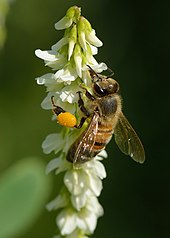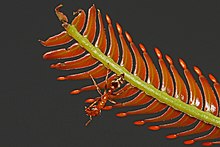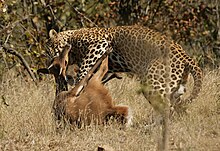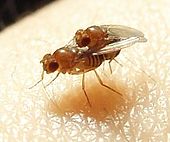Cauchy stress tensor, a second-order tensor. The tensor's components, in a three-dimensional Cartesian coordinate system, form the matrix

whose columns are the stresses (forces per unit area) acting on the e1, e2, and e3 faces of the cube.

whose columns are the stresses (forces per unit area) acting on the e1, e2, and e3 faces of the cube.
In mathematics, tensors are geometric objects that describe linear relations between geometric vectors, scalars, and other tensors. Elementary examples of such relations include the dot product, the cross product, and linear maps. Geometric vectors, often used in physics and engineering applications, and scalars themselves are also tensors.[1] A more sophisticated example is the Cauchy stress tensor T, which takes a direction v as input and produces the stress T(v) on the surface normal to this vector for output, thus expressing a relationship between these two vectors, shown in the figure (right).
Given a reference basis of vectors, a tensor can be represented as an organized multidimensional array of numerical values. The order (also degree or rank) of a tensor is the dimensionality of the array needed to represent it, or equivalently, the number of indices needed to label a component of that array. For example, a linear map is represented by a matrix (a 2-dimensional array) in a basis, and therefore is a 2nd-order tensor. A vector is represented as a 1-dimensional array in a basis, and is a 1st-order tensor. Scalars are single numbers and are thus 0th-order tensors. The collection of tensors on a vector space forms a tensor algebra.
Because they express a relationship between vectors, tensors themselves must be independent of a particular choice of basis. The basis independence of a tensor then takes the form of a covariant and/or contravariant transformation law that relates the array computed in one basis to that computed in another one. The precise form of the transformation law determines the type (or valence) of the tensor. The tensor type is a pair of natural numbers (n, m), where n is the number of contravariant indices and m is the number of covariant indices. The total order of a tensor is the sum of these two numbers.
Tensors are important in physics because they provide a concise mathematical framework for formulating and solving physics problems in areas such as stress, elasticity, fluid mechanics, and general relativity. In applications, it is common to study situations in which a different tensor can occur at each point of an object; for example the stress within an object may vary from one location to another. This leads to the concept of a tensor field. In some areas, tensor fields are so ubiquitous that they are simply called "tensors".
Tensors were conceived in 1900 by Tullio Levi-Civita and Gregorio Ricci-Curbastro, who continued the earlier work of Bernhard Riemann and Elwin Bruno Christoffel and others, as part of the absolute differential calculus. The concept enabled an alternative formulation of the intrinsic differential geometry of a manifold in the form of the Riemann curvature tensor.[2]
Definition
Although seemingly different, the various approaches to defining tensors describe the same geometric concept using different languages and at different levels of abstraction.As multidimensional arrays
Just as a vector in an n-dimensional space is represented by a one-dimensional array of length n with respect to a given basis, any tensor with respect to a basis is represented by a multidimensional array. For example, a linear operator is represented in a basis as a two-dimensional square n × n array. The numbers in the multidimensional array are known as the scalar components of the tensor or simply its components. They are denoted by indices giving their position in the array, as subscripts and superscripts, following the symbolic name of the tensor. For example, the components of an order 2 tensor T could be denoted Tij , where i and j are indices running from 1 to n, or also by T ji. Whether an index is displayed as a superscript or subscript depends on the transformation properties of the tensor, described below. Thus while Tij and T j
i can both be expressed as n by n matrices, and are numerically related via index juggling, the difference in their transformation laws indicates it would be improper to add them together. The total number of indices required to identify each component uniquely is equal to the dimension of the array, and is called the order, degree or rank of the tensor. However, the term "rank" generally has another meaning in the context of matrices and tensors.
Just as the components of a vector change when we change the basis of the vector space, the components of a tensor also change under such a transformation. Each type of tensor comes equipped with a transformation law that details how the components of the tensor respond to a change of basis. The components of a vector can respond in two distinct ways to a change of basis (see covariance and contravariance of vectors), where the new basis vectors
 are expressed in terms of the old basis vectors
are expressed in terms of the old basis vectors  as,
as,As a simple example, the matrix of a linear operator with respect to a basis is a rectangular array
 that transforms under a change of basis matrix
that transforms under a change of basis matrix  by
by  . For the individual matrix entries, this transformation law has the form
. For the individual matrix entries, this transformation law has the form  so the tensor corresponding to the matrix of a linear operator has one
covariant and one contravariant index: it is of type (1,1).
so the tensor corresponding to the matrix of a linear operator has one
covariant and one contravariant index: it is of type (1,1).Combinations of covariant and contraviant components with the same index allow us to express geometric invariants. For example, the fact that a vector is the same object in different coordinate systems can be captured by the following equations, using the formulas defined above:
,
 is the Kronecker delta, which functions similarly to the identity matrix, and has the effect of renaming indices (j into k in this example). This shows several features of the component notation- the ability to re-arrange terms at will (commutativity),
the need to use different indices when working with multiple objects in
the same expression, the ability to rename indices, and the manner in
which contravariant and covariant tensors combine so that all instances
of the transformation matrix and its inverse cancel, so that expressions
like
is the Kronecker delta, which functions similarly to the identity matrix, and has the effect of renaming indices (j into k in this example). This shows several features of the component notation- the ability to re-arrange terms at will (commutativity),
the need to use different indices when working with multiple objects in
the same expression, the ability to rename indices, and the manner in
which contravariant and covariant tensors combine so that all instances
of the transformation matrix and its inverse cancel, so that expressions
like  can immediately be seen to be geometrically identical in all coordinate systems.
can immediately be seen to be geometrically identical in all coordinate systems.Similarly, a linear operator, viewed as a geometric object, does not actually depend on a basis: it is just a linear map that accepts a vector as an argument and produces another vector. The transformation law for the how the matrix of components of a linear operator changes with the basis is consistent with the transformation law for a contravariant vector, so that the action of a linear operator on a contravariant vector is represented in coordinates as the matrix product of their respective coordinate representations. That is, the components
 are given by
are given by  . These components transform contravariantly, since
. These components transform contravariantly, sinceThis discussion motivates the following formal definition:[3][4]
Definition. A tensor of type (p, q) is an assignment of a multidimensional arrayThe definition of a tensor as a multidimensional array satisfying a transformation law traces back to the work of Ricci.[2]
to each basis f = (e1, ..., en) of an n-dimensional vector space such that, if we apply the change of basis
then the multidimensional array obeys the transformation law
![{\displaystyle T_{j'_{1}\dots j'_{q}}^{i'_{1}\dots i'_{p}}[\mathbf {f} \cdot R]=\left(R^{-1}\right)_{i_{1}}^{i'_{1}}\cdots \left(R^{-1}\right)_{i_{p}}^{i'_{p}}}](https://wikimedia.org/api/rest_v1/media/math/render/svg/e58c6ad944ce4ade82f82a8f5fe78375fcc949d1)
![{\displaystyle T_{j_{1},\ldots ,j_{q}}^{i_{1},\ldots ,i_{p}}[\mathbf {f} ]}](https://wikimedia.org/api/rest_v1/media/math/render/svg/7076a7d3a987273f780cb2149bf3b75bf5b88a57)
An equivalent definition of a tensor uses the representations of the general linear group. There is an action of the general linear group on the set of all ordered bases of an n-dimensional vector space. If
 is an ordered basis, and
is an ordered basis, and  is an invertible
is an invertible  matrix, then the action is given by
matrix, then the action is given by be a representation of GL(n) on W (that is, a group homomorphism
be a representation of GL(n) on W (that is, a group homomorphism  ). Then a tensor of type
). Then a tensor of type  is an equivariant map
is an equivariant map  . Equivariance here means that
. Equivariance here means that is a tensor representation
of the general linear group, this gives the usual definition of tensors
as multidimensional arrays. This definition is often used to describe
tensors on manifolds,[5] and readily generalizes to other groups.[3]
is a tensor representation
of the general linear group, this gives the usual definition of tensors
as multidimensional arrays. This definition is often used to describe
tensors on manifolds,[5] and readily generalizes to other groups.[3]As multilinear maps
A downside to the definition of a tensor using the multidimensional array approach is that it is not apparent from the definition that the defined object is indeed basis independent, as is expected from an intrinsically geometric object. Although it is possible to show that transformation laws indeed ensure independence from the basis, sometimes a more intrinsic definition is preferred. One approach that is common in differential geometry is to define tensors relative to a fixed (finite-dimensional) vector space V, which is usually taken to be a particular vector space of some geometrical significance like the tangent space to a manifold.[6] In this approach, a type (p, q) tensor T is defined as a multilinear map,By applying a multilinear map T of type (p, q) to a basis {ej} for V and a canonical cobasis {εi} for V∗,
In viewing a tensor as a multilinear map, it is conventional to identify the vector space V with the space of linear functionals on the dual of V, the double dual V∗∗. There is always a natural linear map from V to its double dual, given by evaluating a linear form in V∗ against a vector in V. This linear mapping is an isomorphism in finite dimensions, and it is often then expedient to identify V with its double dual.
Using tensor products
For some mathematical applications, a more abstract approach is sometimes useful. This can be achieved by defining tensors in terms of elements of tensor products of vector spaces, which in turn are defined through a universal property. A type (p, q) tensor is defined in this context as an element of the tensor product of vector spaces,[7][8]Tensor products can be defined in great generality – for example, involving arbitrary modules over a ring. In principle, one could define a "tensor" simply to be an element of any tensor product. However, the mathematics literature usually reserves the term tensor for an element of a tensor product of any number of copies of a single vector space V and its dual, as above.
Tensors in infinite dimensions
This discussion of tensors so far assumes finite dimensionality of the spaces involved, where the spaces of tensors obtained by each of these constructions are naturally isomorphic.[Note 2] Constructions of spaces of tensors based on the tensor product and multilinear mappings can be generalized, essentially without modification, to vector bundles or coherent sheaves.[9] For infinite-dimensional vector spaces, inequivalent topologies lead to inequivalent notions of tensor, and these various isomorphisms may or may not hold depending on what exactly is meant by a tensor (see topological tensor product). In some applications, it is the tensor product of Hilbert spaces that is intended, whose properties are the most similar to the finite-dimensional case. A more modern view is that it is the tensors' structure as a symmetric monoidal category that encodes their most important properties, rather than the specific models of those categories.[10]Tensor fields
In many applications, especially in differential geometry and physics, it is natural to consider a tensor with components that are functions of the point in a space. This was the setting of Ricci's original work. In modern mathematical terminology such an object is called a tensor field, often referred to simply as a tensor.[2]In this context, a coordinate basis is often chosen for the tangent vector space. The transformation law may then be expressed in terms of partial derivatives of the coordinate functions,
Examples
This table shows important examples of tensors on vector spaces and tensor fields on manifolds. The tensors are classified according to their type (n, m), where n is the number of contravariant indices, m is the number of covariant indices, and n + m gives the total order of the tensor. For example, a bilinear form is the same thing as a (0, 2)-tensor; an inner product is an example of a (0, 2)-tensor, but not all (0, 2)-tensors are inner products. In the (0, M)-entry of the table, M denotes the dimensionality of the underlying vector space or manifold because for each dimension of the space, a separate index is needed to select that dimension to get a maximally covariant antisymmetric tensor.-
m 0 1 2 3 ⋯ M ⋯ n 0 Scalar, e.g. scalar curvature Covector, linear functional, 1-form, e.g. dipole moment, gradient of a scalar field Bilinear form, e.g. inner product, quadrupole moment, metric tensor, Ricci curvature, 2-form, symplectic form 3-form E.g. octupole moment E.g. M-form i.e. volume form 1 Vector, e.g. direction vector Linear transformation,[11] Kronecker delta E.g. cross product in three dimensions E.g. Riemann curvature tensor 2 Inverse metric tensor, bivector, e.g., Poisson structure E.g. elasticity tensor ⋮ N N-vector, a sum of N-blades ⋮
Geometric interpretation of grade n elements in a real exterior algebra for n = 0 (signed point), 1 (directed line segment, or vector), 2 (oriented plane element), 3 (oriented volume). The exterior product of n vectors can be visualized as any n-dimensional shape (e.g. n-parallelotope, n-ellipsoid); with magnitude (hypervolume), and orientation defined by that on its n − 1-dimensional boundary and on which side the interior is.[12][13]
Notation
There are several notational systems that are used to describe tensors and perform calculations involving them.Ricci calculus
Ricci calculus is the modern formalism and notation for tensor indices: indicating inner and outer products, covariance and contravariance, summations of tensor components, symmetry and antisymmetry, and partial and covariant derivatives.Einstein summation convention
The Einstein summation convention dispenses with writing summation signs, leaving the summation implicit. Any repeated index symbol is summed over: if the index i is used twice in a given term of a tensor expression, it means that the term is to be summed for all i. Several distinct pairs of indices may be summed this way.Penrose graphical notation
Penrose graphical notation is a diagrammatic notation which replaces the symbols for tensors with shapes, and their indices by lines and curves. It is independent of basis elements, and requires no symbols for the indices.Abstract index notation
The abstract index notation is a way to write tensors such that the indices are no longer thought of as numerical, but rather are indeterminates. This notation captures the expressiveness of indices and the basis-independence of index-free notation.Component-free notation
A component-free treatment of tensors uses notation that emphasises that tensors do not rely on any basis, and is defined in terms of the tensor product of vector spaces.Operations
There are several operations on tensors that again produce a tensor. The linear nature of tensor implies that two tensors of the same type may be added together, and that tensors may be multiplied by a scalar with results analogous to the scaling of a vector. On components, these operations are simply performed component-wise. These operations do not change the type of the tensor; but there are also operations that produce a tensor of different type.Tensor product
The tensor product takes two tensors, S and T, and produces a new tensor, S ⊗ T, whose order is the sum of the orders of the original tensors. When described as multilinear maps, the tensor product simply multiplies the two tensors, i.e.Contraction
Tensor contraction is an operation that reduces a type (n, m) tensor to a type (n − 1, m − 1) tensor, of which the trace is a special case. It thereby reduces the total order of a tensor by two. The operation is achieved by summing components for which one specified contravariant index is the same as one specified covariant index to produce a new component. Components for which those two indices are different are discarded. For example, a (1, 1)-tensor can be contracted to a scalar through
can be contracted to a scalar through
.
The contraction is often used in conjunction with the tensor product to contract an index from each tensor.
The contraction can also be understood using the definition of a tensor as an element of a tensor product of copies of the space V with the space V∗ by first decomposing the tensor into a linear combination of simple tensors, and then applying a factor from V∗ to a factor from V. For example, a tensor
 can be contracted to a scalar through
can be contracted to a scalar throughRaising or lowering an index
When a vector space is equipped with a nondegenerate bilinear form (or metric tensor as it is often called in this context), operations can be defined that convert a contravariant (upper) index into a covariant (lower) index and vice versa. A metric tensor is a (symmetric) (0, 2)-tensor; it is thus possible to contract an upper index of a tensor with one of the lower indices of the metric tensor in the product. This produces a new tensor with the same index structure as the previous tensor, but with lower index generally shown in the same position of the contracted upper index. This operation is quite graphically known as lowering an index.Conversely, the inverse operation can be defined, and is called raising an index. This is equivalent to a similar contraction on the product with a (2, 0)-tensor. This inverse metric tensor has components that are the matrix inverse of those of the metric tensor.
Applications
Continuum mechanics
Important examples are provided by continuum mechanics. The stresses inside a solid body or fluid are described by a tensor field. The stress tensor and strain tensor are both second-order tensor fields, and are related in a general linear elastic material by a fourth-order elasticity tensor fields. In detail, the tensor quantifying stress in a 3-dimensional solid object has components that can be conveniently represented as a 3 × 3 array. The three faces of a cube-shaped infinitesimal volume segment of the solid are each subject to some given force. The force's vector components are also three in number. Thus, 3 × 3, or 9 components are required to describe the stress at this cube-shaped infinitesimal segment. Within the bounds of this solid is a whole mass of varying stress quantities, each requiring 9 quantities to describe. Thus, a second-order tensor is needed.If a particular surface element inside the material is singled out, the material on one side of the surface will apply a force on the other side. In general, this force will not be orthogonal to the surface, but it will depend on the orientation of the surface in a linear manner. This is described by a tensor of type (2, 0), in linear elasticity, or more precisely by a tensor field of type (2, 0), since the stresses may vary from point to point.
Other examples from physics
Common applications include- Electromagnetic tensor (or Faraday tensor) in electromagnetism
- Finite deformation tensors for describing deformations and strain tensor for strain in continuum mechanics
- Permittivity and electric susceptibility are tensors in anisotropic media
- Four-tensors in general relativity (e.g. stress–energy tensor), used to represent momentum fluxes
- Spherical tensor operators are the eigenfunctions of the quantum angular momentum operator in spherical coordinates
- Diffusion tensors, the basis of diffusion tensor imaging, represent rates of diffusion in biologic environments
- Quantum mechanics and quantum computing utilise tensor products for combination of quantum states
Applications of tensors of order > 2
The concept of a tensor of order two is often conflated with that of a matrix. Tensors of higher order do however capture ideas important in science and engineering, as has been shown successively in numerous areas as they develop. This happens, for instance, in the field of computer vision, with the trifocal tensor generalizing the fundamental matrix.The field of nonlinear optics studies the changes to material polarization density under extreme electric fields. The polarization waves generated are related to the generating electric fields through the nonlinear susceptibility tensor. If the polarization P is not linearly proportional to the electric field E, the medium is termed nonlinear. To a good approximation (for sufficiently weak fields, assuming no permanent dipole moments are present), P is given by a Taylor series in E whose coefficients are the nonlinear susceptibilities:
 is the linear susceptibility,
is the linear susceptibility,  gives the Pockels effect and second harmonic generation, and
gives the Pockels effect and second harmonic generation, and  gives the Kerr effect. This expansion shows the way higher-order tensors arise naturally in the subject matter.
gives the Kerr effect. This expansion shows the way higher-order tensors arise naturally in the subject matter.Generalizations
Tensor products of vector spaces
The vector spaces of a tensor product need not be the same, and sometimes the elements of such a more general tensor product are called "tensors". For example, an element of the tensor product space V ⊗ W is a second-order "tensor" in this more general sense,[14] and an order-d tensor may likewise be defined as an element of a tensor product of d different vector spaces.[15] A type (n, m) tensor, in the sense defined previously, is also a tensor of order n + m in this more general sense. The concept of tensor product can be extended to arbitrary modules over a ring.Tensors in infinite dimensions
The notion of a tensor can be generalized in a variety of ways to infinite dimensions. One, for instance, is via the tensor product of Hilbert spaces.[16] Another way of generalizing the idea of tensor, common in nonlinear analysis, is via the multilinear maps definition where instead of using finite-dimensional vector spaces and their algebraic duals, one uses infinite-dimensional Banach spaces and their continuous dual.[17] Tensors thus live naturally on Banach manifolds[18] and Fréchet manifolds.Tensor densities
Suppose that a homogeneous medium fills R3, so that the density of the medium is described by a single scalar value ρ in kg m−3. The mass, in kg, of a region Ω is obtained by multiplying ρ by the volume of the region Ω, or equivalently integrating the constant ρ over the region: to compensate, so that the numerical value of the mass in kg is still given by integral of
to compensate, so that the numerical value of the mass in kg is still given by integral of  . Thus
. Thus  (in units of kg cm−3).
(in units of kg cm−3).More generally, if the Cartesian coordinates xyz undergo a linear transformation, then the numerical value of the density ρ must change by a factor of the reciprocal of the absolute value of the determinant of the coordinate transformation, so that the integral remains invariant, by the change of variables formula for integration. Such a quantity that scales by the reciprocal of the absolute value of the determinant of the coordinate transition map is called a scalar density. To model a non-constant density, ρ is a function of the variables xyz (a scalar field), and under a curvilinear change of coordinates, it transforms by the reciprocal of the Jacobian of the coordinate change. For more on the intrinsic meaning, see Density on a manifold.
A tensor density transforms like a tensor under a coordinate change, except that it in addition picks up a factor of the absolute value of the determinant of the coordinate transition:[19]
Under an affine transformation of the coordinates, a tensor transforms by the linear part of the transformation itself (or its inverse) on each index. These come from the rational representations of the general linear group. But this is not quite the most general linear transformation law that such an object may have: tensor densities are non-rational, but are still semisimple representations. A further class of transformations come from the logarithmic representation of the general linear group, a reducible but not semisimple representation,[22] consisting of an (x,y) ∈ R2 with the transformation law
Geometric objects
The transformation law for a tensor behaves as a functor on the category of admissible coordinate systems, under general linear transformations (or, other transformations within some class, such as local diffeomorphisms.) This makes a tensor a special case of a geometrical object, in the technical sense that it is a function of the coordinate system transforming functorially under coordinate changes.[23] Examples of objects obeying more general kinds of transformation laws are jets and, more generally still, natural bundles.[24][25]Spinors
When changing from one orthonormal basis (called a frame) to another by a rotation, the components of a tensor transform by that same rotation. This transformation does not depend on the path taken through the space of frames. However, the space of frames is not simply connected (see orientation entanglement and plate trick): there are continuous paths in the space of frames with the same beginning and ending configurations that are not deformable one into the other. It is possible to attach an additional discrete invariant to each frame that incorporates this path dependence, and which turns out (locally) to have values of ±1.[26] A spinor is an object that transforms like a tensor under rotations in the frame, apart from a possible sign that is determined by the value of this discrete invariant.[27][28]Succinctly, spinors are elements of the spin representation of the rotation group, while tensors are elements of its tensor representations. Other classical groups have tensor representations, and so also tensors that are compatible with the group, but all non-compact classical groups have infinite-dimensional unitary representations as well.
History
The concepts of later tensor analysis arose from the work of Carl Friedrich Gauss in differential geometry, and the formulation was much influenced by the theory of algebraic forms and invariants developed during the middle of the nineteenth century.[29] The word "tensor" itself was introduced in 1846 by William Rowan Hamilton[30] to describe something different from what is now meant by a tensor.[Note 3] The contemporary usage was introduced by Woldemar Voigt in 1898.[31]Tensor calculus was developed around 1890 by Gregorio Ricci-Curbastro under the title absolute differential calculus, and originally presented by Ricci in 1892.[32] It was made accessible to many mathematicians by the publication of Ricci and Tullio Levi-Civita's 1900 classic text Méthodes de calcul différentiel absolu et leurs applications (Methods of absolute differential calculus and their applications).[33]
In the 20th century, the subject came to be known as tensor analysis, and achieved broader acceptance with the introduction of Einstein's theory of general relativity, around 1915. General relativity is formulated completely in the language of tensors. Einstein had learned about them, with great difficulty, from the geometer Marcel Grossmann.[34] Levi-Civita then initiated a correspondence with Einstein to correct mistakes Einstein had made in his use of tensor analysis. The correspondence lasted 1915–17, and was characterized by mutual respect:
I admire the elegance of your method of computation; it must be nice to ride through these fields upon the horse of true mathematics while the like of us have to make our way laboriously on foot.Tensors were also found to be useful in other fields such as continuum mechanics. Some well-known examples of tensors in differential geometry are quadratic forms such as metric tensors, and the Riemann curvature tensor. The exterior algebra of Hermann Grassmann, from the middle of the nineteenth century, is itself a tensor theory, and highly geometric, but it was some time before it was seen, with the theory of differential forms, as naturally unified with tensor calculus. The work of Élie Cartan made differential forms one of the basic kinds of tensors used in mathematics.
— Albert Einstein[35]
From about the 1920s onwards, it was realised that tensors play a basic role in algebraic topology (for example in the Künneth theorem).[36] Correspondingly there are types of tensors at work in many branches of abstract algebra, particularly in homological algebra and representation theory. Multilinear algebra can be developed in greater generality than for scalars coming from a field. For example, scalars can come from a ring. But the theory is then less geometric and computations more technical and less algorithmic.[37] Tensors are generalized within category theory by means of the concept of monoidal category, from the 1960s.[38]




![{\displaystyle \left({\widehat {Tv}}\right)^{i'}={\hat {T}}_{j'}^{i'}{\hat {v}}^{j'}=\left[\left(R^{-1}\right)_{i}^{i'}T_{j}^{i}R_{j'}^{j}\right]\left[\left(R^{-1}\right)_{j}^{j'}v^{j}\right]=\left(R^{-1}\right)_{i}^{i'}(Tv)^{i}.}](https://wikimedia.org/api/rest_v1/media/math/render/svg/901bd4c8d792bbe6a60e10e49ca026f412f9b8d3)



![T_{j_{1}\dots j_{q}}^{i_{1}\dots i_{p}}[\mathbf {f} ]](https://wikimedia.org/api/rest_v1/media/math/render/svg/5c5971d3e9c4311001522ff021018a8210a3b184)




















![{\displaystyle T_{j'_{1}\dots j'_{q}}^{i'_{1}\dots i'_{p}}[\mathbf {f} \cdot R]=|\det R|^{-w}\left(R^{-1}\right)_{i_{1}}^{i'_{1}}\cdots \left(R^{-1}\right)_{i_{p}}^{i'_{p}}}](https://wikimedia.org/api/rest_v1/media/math/render/svg/eac6d4dd5599d9ef812b2b4e38003dd7bcdc56b3)













